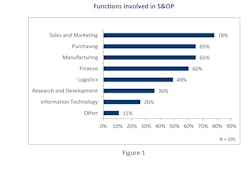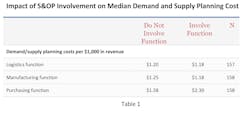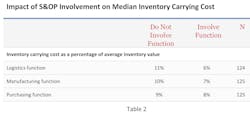The "S" in S&OP Can Stand for Supply Chain, Too
Sales and operations planning (S&OP) has the potential to promote visibility within the enterprise and foster collaboration among business functions. However, the functions involved in the S&OP effort can vary from organization to organization. APQC asks organizations participating in its Open Standards Benchmarking in supply chain planning to indicate the business functions they involve in S&OP (Figure 1). Not surprisingly, sales and marketing is involved more often than not, with more than two-thirds of responding organizations indicating that they involve this function. Less frequently involved are supply chain functions, with 65% of responding organizations indicating that they include the purchasing and manufacturing functions and less than half reporting that they include the logistics function.
Demand and Supply Planning Costs
Table 1 presents the median performance of organizations with regard to demand and supply planning costs per $1,000 in revenue. Organizations that involve the logistics function and the manufacturing function in the S&OP process spend slightly less at the median on demand and supply planning per $1,000 in revenue than organizations that do not involve each of these functions. However, organizations that involve the purchasing function in S&OP spend $0.72 more per $1,000 in revenue on demand and supply planning than organizations that do not. For an organization with $5 billion in annual revenue, this would result in $3.6 million in additional demand and supply planning costs associated with involving the purchasing function in the S&OP process.
Table 2 presents organizations’ median inventory carrying cost as a percentage of average inventory value. Organizations that involve each of the supply chain functions spend much less to store and maintain inventory than organizations that do not involve each of these functions. The difference is largest when considering the involvement of the logistics function: the median inventory carrying cost for organizations that involve the logistics function in the S&OP process is almost half as much as that of organizations that do not involve this function. Organizations that involve the purchasing function have a 1% lower inventory carrying cost than organizations that do not involve this function. Although this difference may not seem large, for an organization with $1 billion in average inventory value, a 1% difference would translate into $10 million in additional inventory carrying cost.
The difference in performance illustrated in Table 2 indicates that involving the supply chain functions in S&OP can have a significant effect on the ability of an organization to plan for demand and thus to maintain an optimum amount of inventory. Keeping these functions involved in discussions regarding demand and production plans can enable the organization to optimize planning, purchasing and manufacturing to reduce the amount of inventory that must be stored.
Weigh the Effects
APQC’s data show that involving the supply chain functions (purchasing, logistics and manufacturing) in the S&OP process is associated with a lower inventory carrying cost and lower cost to conduct demand and supply planning. The exception to this is with organizations that involve the purchasing function, which incur higher costs for demand and supply planning than organizations that do not involve this function. However, the lower inventory carrying cost obtained by this group of organizations may help offset any additional costs generated in the demand and supply planning process.
Because S&OP affects the entire supply chain, organizations should give serious thought to involving representatives from the supply chain functions in this process. Organizations should consider whether any additional costs incurred in the planning process would be offset by increased efficiency or costs savings generated within the procurement, manufacturing, or logistics functions. It may be that involving the supply chain in S&OP is worth the investment.
Becky Partida is a research specialist, supply chain management, with APQC, a member-based nonprofit and one of the leading proponents of benchmarking and best practice business research.







